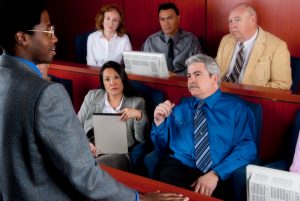Browsing Facility Situations: How to Create Reliable Trial Presentations for Optimum Outcomes
Browsing Facility Situations: How to Create Reliable Trial Presentations for Optimum Outcomes
Blog Article
Navigating the Intricacies of Test Presentations: Tips for Seamless Delivery and Engaging Arguments
In the world of legal process, the art of trial discussion stands as a critical component of success. As attorneys browse the intricate web of court room characteristics, the capacity to flawlessly provide debates and evidence while mesmerizing the court's attention ends up being vital. The complexities intrinsic in test presentations require a delicate balance of ability, finesse, and strategy. By developing strategies that make certain a sleek distribution and crafting engaging debates that reverberate with the audience, lawful specialists can significantly boost their campaigning for. In a globe where persuasion preponderates, grasping the ins and outs of trial presentations is not just a choice yet a need for those seeking to dominate in the courtroom.

Comprehending Trial Goals
To efficiently navigate a test, it is essential to have a clear understanding of the purposes that need to be attained. Prior to entering the court, lawful groups must specify their goals and desired end results. These purposes function as assisting principles throughout the test, shaping strategies and affecting decision-making procedures.
Recognizing trial goals involves an extensive evaluation of the instance, legal criteria, and the client's best passions. Trial Presentations. It requires a careful examination of the truths, recognizing key problems, and expecting possible obstacles. By establishing measurable and certain objectives, attorneys can tailor their disagreements and presentations to straighten with the wanted results
Additionally, a clear grip of trial purposes enables legal groups to prioritize proof, witnesses, and lawful disagreements successfully. It permits for the growth of a meaningful story that resonates with the discretionary, enhancing the overall instance presentation.

Organizing Evidence Efficiently
Having a clear understanding of trial objectives lays the foundation for arranging evidence efficiently in legal procedures - Trial Presentations. By lining up the discussion of proof with the wanted outcomes of the test, legal groups can reinforce their debates and enhance their persuasiveness. One vital facet of organizing evidence is classification. Organizing evidence based upon styles or importance to specific lawful aspects can assist enhance the presentation and make complex information extra digestible for the judge or court.
An additional crucial element in organizing evidence efficiently is establishing a sensible flow. Presenting proof in a systematic and consecutive way can aid build a compelling narrative that sustains the lawful arguments being made. In addition, using aesthetic help such as graphes, charts, or timelines can further boost the company of evidence and assist in making clear complicated relationships or sequences of events.
Additionally, making sure that all proof offered is relevant and admissible to the situation is essential. Inadmissible or unnecessary proof can interfere with the strength of the argument and potentially harm the reputation of today party. A careful evaluation and selection process ought to be embarked on to include just the most legally audio and impactful evidence in the trial presentation.
Crafting Convincing Stories
Crafting compelling narratives plays a critical function in presenting convincing debates throughout lawful process. When constructing a narrative for a test discussion, it is essential to establish a clear story that highlights vital points and connects them in a meaningful way. By weaving together Read More Here proof, testament, and lawful disagreements right into a natural and influential story, lawful professionals can properly promote for their clients and enhance the likelihood of a desirable end result in the courtroom.
Understanding Visual Aids
Effective usage of visual help is vital to improving the influence and clarity of test presentations. Visual help, when utilized strategically, have the power to simplify intricate information, enhance bottom lines, and leave a lasting impact on the judge and jury. To master aesthetic help in trial discussions, it is vital to guarantee that they are clear, concise, and relevant to the disagreements being made.
When including visual help, such as graphes, photographs, graphs, or timelines, right into a trial presentation, it is important to keep them aesthetically appealing yet specialist. The visuals should match the verbal debates, offering a visual depiction of the details being discussed without overwhelming the target market with unneeded details.
Furthermore, exercising with the visual aids beforehand is crucial to make certain a smooth distribution throughout the test. Familiarizing oneself with the content, changes, and timings of each visual help can assist maintain the circulation of the presentation and prevent technological problems that may occur.
Delivering Impactful Closing Arguments
A compelling closing argument works as the end result of a test presentation, enveloping the core narrative and convincing the discretionary towards a positive decision. To deliver an impactful closing debate, it is critical to succinctly wrap up bottom lines, highlight the strengths of your situation, and address any weak points in a calculated fashion. Begin by detailing the main disagreements that sustain your client's placement, highlighting why the evidence provided throughout the test sustains your story. It is important to develop a sense of cohesion and quality, directing the discretionary in the direction of the wanted verdict.
In addition, including sob story can additionally reinforce your closing disagreement. By humanizing the situation and linking on a personal level with the decision-makers, you can stimulate empathy and understanding, influencing their understanding of the realities offered. these details Furthermore, repeating the legal criteria that should be met for a beneficial ruling can strengthen the credibility of your setting. Eventually, a well-crafted closing argument need to leave a long-term impact, engaging the discretionary to rule in your client's favor.
Verdict
Finally, understanding trial discussions involves recognizing objectives, arranging evidence, crafting stories, using aesthetic help, and delivering impactful closing disagreements. By executing these approaches efficiently, attorneys can offer their case effortlessly and make engaging debates in the court room. It is vital to navigate the intricacies of test presentations with precision and skill to accomplish success in Continue legal process.
By lining up the discussion of proof with the wanted results of the test, lawful teams can enhance their disagreements and boost their persuasiveness (Trial Presentations). To understand aesthetic help in test discussions, it is vital to make certain that they are clear, succinct, and appropriate to the disagreements being made
An engaging closing debate offers as the conclusion of a trial presentation, encapsulating the core narrative and persuading the judge and court towards a beneficial decision. Begin by outlining the major debates that support your customer's position, emphasizing why the proof provided throughout the trial sustains your narrative.In final thought, understanding test discussions includes understanding purposes, organizing proof, crafting stories, making use of visual aids, and supplying impactful closing debates.
Report this page